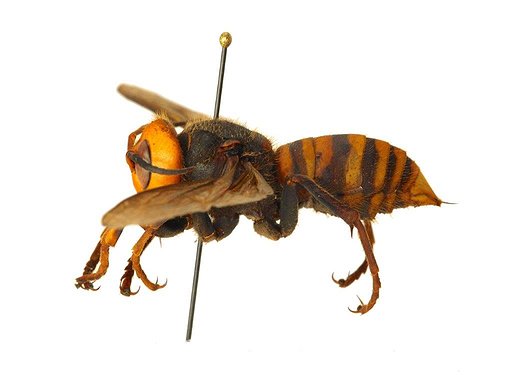Asian giant hornet officially eradicated in Washington
OLYMPIA — The Washington State Department of Agriculture has announced the successful eradication of the northern giant hornet, a five-year effort involving state officials, local landowners, beekeepers and citizen scientists. The group effort eliminated the invasive species from the state when it could have spread from the northwestern corner of the Evergreen State to the rest of the region.
“It is a rare day when the humans actually get to win one against the insects,” the Pest Program Manager at WSDA Sven-Erik Spichiger said.
This invasive species, known for its devastating impact on bee populations, was first detected in Washington in December 2019.
“None of this would be possible without everybody in Washington State and also from other parts of the country and other parts of the world that really helped make this possible,” Spichiger said.
He acknowledged the vital role played by landowners in Whatcom County, in particular.
“The landowners generously allowed us access to their properties for trapping and eradication activities,” he said.
The cumulative efforts over the years led to the final trap being removed Dec. 5, with no additional hornets found since 2021.
“I am absolutely honored to announce that eradication has been achieved and it's a significant victory for everybody who's involved,” Spichiger said.
The eradication effort was multifaceted and involved various stakeholders, according to the WSDA press release. Local beekeepers took the initiative to aid the WSDA by deploying spring traps to capture emerging queens, while citizen scientists participated in trapping and monitoring activities.
“To me, this was absolutely huge because it allowed us to focus our resources in areas where we knew we had hornets,” Spichiger said.
The eradication initiative was initiated in response to public concerns after reports surfaced in 2013 of 42 fatalities resulting from hornet attacks in China, prompting discussions on potential responses to invasive species in the U.S.
In 2016, a framework for responding to invasive hornets was developed, anticipating the need for rapid action in the event of an introduction. Spichiger explained how this groundwork supported their response strategy.
“You know, we had a couple programs available that allowed citizen scientists to trap Asian giant hornets,” Spichiger said, recognizing the important contributions from the community that led to success in the eradication process.
The cooperative efforts came to fruition when WSDA successfully located and eradicated the first nest in October 2020, facilitated by advanced tracking technology borrowed from the United States Department of Agriculture.
Nicole Russo, associate deputy administrator at USDA, expressed gratitude for the collaborative nature of the eradication.
“A strong partnership between USDA's Animal and Plant Health Inspection Service and WSDA was an essential component of eradicating the Northern Giant Hornet from the United States,” Russo said. “True to what we often see when partners come together to fight a destructive pest, a shared goal and determination brought promising results.”
As the battle against the hornet continued, community involvement became pivotal. Trappers worked in challenging conditions to check traps and check for hornet activity. During the three-year effort, multiple nests were detected and successfully eradicated.
Efforts took place against the backdrop of the COVID-19 pandemic, which led to further complications. Despite these challenges, the team succeeded in tracking and eradicating multiple hornet nests, employing innovative methods such as radio telemetry technology.
“The partnership with WSDA and APHIS was key to this remarkable accomplishment,” Russo said, stating how the teams used tracking devices initially developed for other pest management efforts.
Greg Halbrick, assistant director of the Plant Protection Division at WSDA, emphasized the importance of community support in their operation.
“The amazing citizens of Whatcom County, including the beekeepers and citizen scientists that hung their traps, were extremely helpful,” he said.
Despite the announcement of eradication, Spichiger cautioned that vigilance must continue.
“Although it is an absolutely significant victory, we won this battle. The battle will continue,” he said, citing the ongoing risk of other invasive species, such as the yellow-legged hornet and the southern giant hornet recently discovered in Spain.
The involvement of the community and multiple agencies proved critical in the success of the Asian giant hornet eradication project.
“The fact of the matter is, if the entire community hadn't stood up and taken action, there is a real good chance that we would just all be living with northern giant hornet for years to come,” Spichiger said. “It is a very difficult task to eradicate an insect once it has become well established. And these were established enough that they were actually attacking resources already.”
 The Asian giant hornet, after five years of attacking Washington ecosystems, has been declared eradicated from the state, according to the Washington Department of Agriculture. The hornet managed to set-up around five nests, located around Whatcom County; however, with the help of state officials, landowners and citizen scientists, the hornet is no longer in Washington.
The Asian giant hornet, after five years of attacking Washington ecosystems, has been declared eradicated from the state, according to the Washington Department of Agriculture. The hornet managed to set-up around five nests, located around Whatcom County; however, with the help of state officials, landowners and citizen scientists, the hornet is no longer in Washington.

